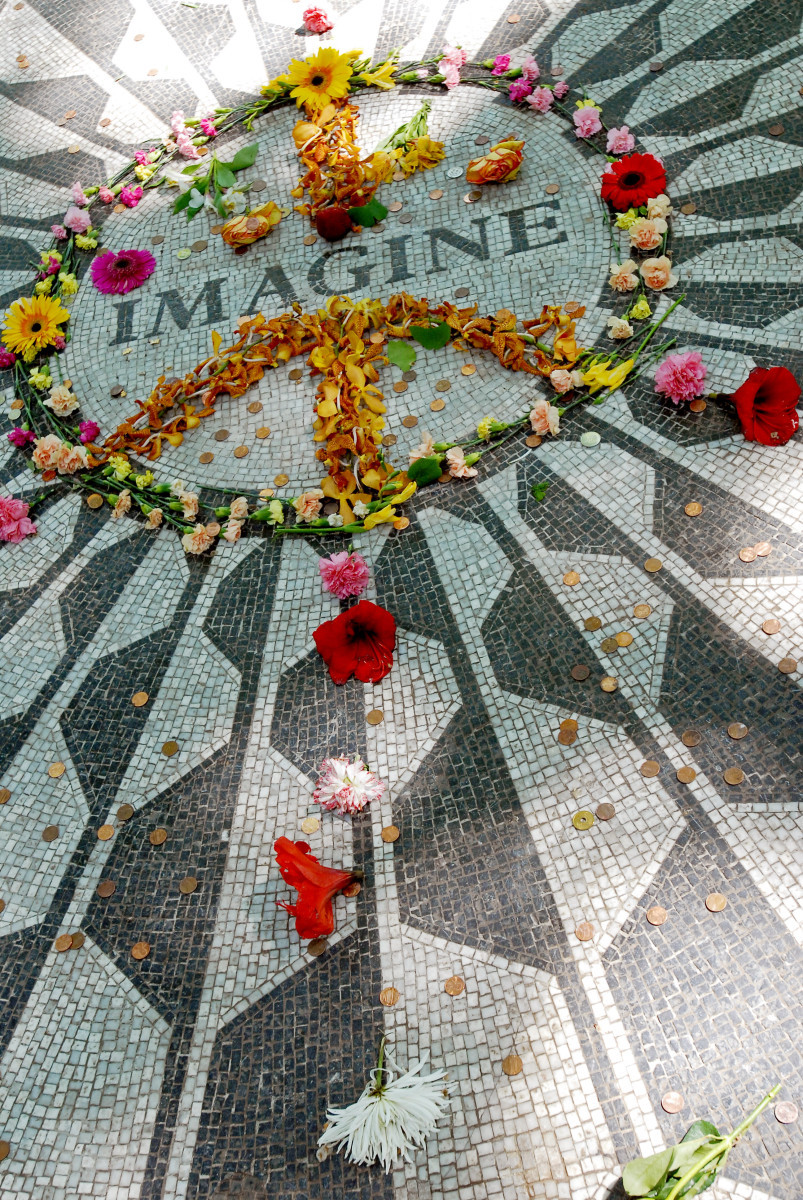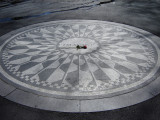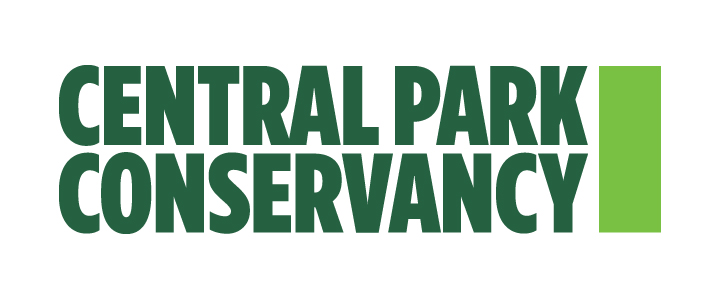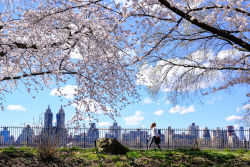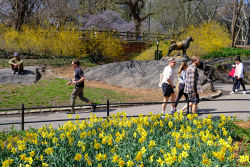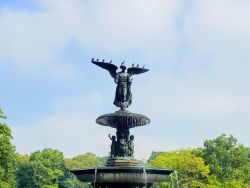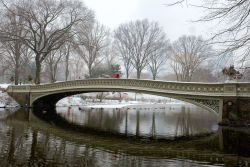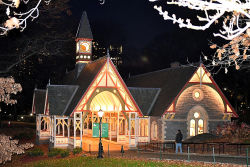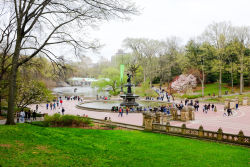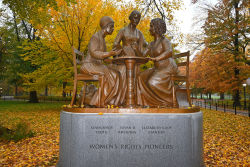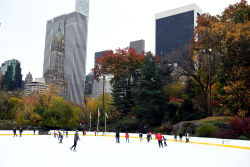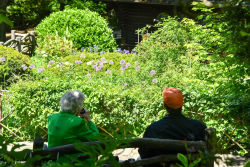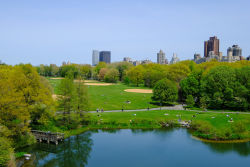Central Park
View all monuments in NYC Parks, as well as temporary public art installations on our NYC Public Art Map and Guide.
Imagine
| Dedicated: | October 9, 1985 |
| Location: | Strawberry Fields, Central Park West and 72nd Street |
Artwork History
Strawberry Fields is a living memorial to the world-famous singer, songwriter, and social activist John Lennon (1940–1980). This area of Central Park was named in 1981, and the re-landscaped Strawberry Fields was dedicated in 1985.
John Lennon was born on October 9, 1940 in a working-class neighborhood in Liverpool, England, and raised by his aunt in the suburb of Woolten. In 1956, Lennon took up guitar and formed his first rock group, the Quarrymen. The following year, Lennon met Paul McCartney, another young musician, and he became a fellow band member and Lennon’s main musical collaborator. In 1958, George Harrison (1943-2001) joined the Quarrymen, which evolved into the Beatles. With the inclusion of Ringo Starr (Richard Starkey), the legendary band debuted in 1960.
Over the next decade, the Beatles made history, challenging the boundaries of contemporary music, and in the process became one of the most famous and influential bands in the world. In 1966, Lennon met his second wife, Japanese conceptual artist Yoko Ono, and married Ono, his later collaborator, in 1969.
After the Beatles disbanded in 1970, Lennon embarked on a successful solo career. His musical releases from this period include Imagine (1971), Mind Games (1974) and Walls and Bridges (1974). Lennon was also an outspoken pacifist and a champion of a myriad of political causes during this period, which brought him under the scrutiny of the Federal Bureau of Investigation (FBI). In the 1970s Lennon and Ono settled in New York, and in 1973 moved into the landmark Dakota Apartments (designed by Henry J. Hardenbergh, 1880-1884).
Lennon and Ono’s son, Sean, was born in 1975 (Lennon had his first son, Julian, with his first wife, Cynthia, in 1963), and after a period of relative domesticity, Lennon’s career resumed in 1980 with the wildly popular release of the single “Starting Over” and the album Double Fantasy. On December 8, 1980, obsessed fan Mark David Chapman fatally shot Lennon in front of his home, an event that shocked the city and was felt around the world.
On March 26, 1981, the City Council adopted legislation introduced by then-Council Member Henry J. Stern on December 18, 1980, which designated this tear-shaped Central Park knoll, located on the west side of Central Park near 72nd Street, as Strawberry Fields.
“Strawberry Fields,” was one of the Beatles’s best-known songs, written by Lennon and recorded on November 24, 1966. With surreal lyrics and music, the song was inspired by a Salvation Army orphanage, Strawberry Field, near Lennon’s childhood home in Woolton. Paul McCartney later recalled, “we related it to youth, golden summers, and fields of strawberry.” Though intended originally for the watershed 1967 album Sergeant Pepper’s Lonely Hearts Club Band, the song was instead released prior to the album on February 13, 1967. Appearing as a double A-side single with Penny Lane, the song was issued again late in 1967 on the album, Magical Mystery Tour. On the recording, an electronic instrument called a Mellotron was used to simulate other instruments (an innovation in popular song), and the final single was stitched together from two different versions.
In 1984, Yoko Ono contributed $500,000 to redesign and renovate Strawberry Fields, and an equivalent amount for an ongoing maintenance endowment. Landscape architect Bruce Kelly designed a meditative Garden of Peace, rich in trees, shrubs and flowers, which was integrated with the historic landscape of Frederick Law Olmsted (1822–1903) and Calvert Vaux (1824–1895). At the western apex of the garden, Neopolitan artisans crafted a circular black and white mosaic emblem into the pavement, containing a starburst pattern and the solitary word, “Imagine,” the title of one of Lennon’s most famous songs. 150 nations were enlisted to contribute plants to the garden, thus embodying the principle of world peace for which Lennon was such an influential advocate. On October 9, 1985, on the 45th anniversary of Lennon’s birth, Strawberry Fields was dedicated, and has become a pilgrimage site for visitors to New York from around the world.
Artwork Details
| Description: | Mosaic roundel with starburst design set in pavement, plaque set in rock outcropping about a hundred yards east of roundel |
| Architect: | Bruce Kelly |
| Materials: | Neapolitan black and white marble, bronze |
| Dimensions: | Circumference: 34'3" (approximate) |
| Donor: | Gift of the city of Naples, Italy |
| Cast: | 1985 |
Inscription
1) Mosaic: IMAGINE2) Plaque: IMAGINE ALL THE PEOPLE LIVING LIFE IN PEACE /---/ JOHN LENNON / [names of 118 countries arranged in vertical columns] / THE TREES AND STONES IN THIS GARDEN OF PEACE WERE DEDICATED / BY THE ABOVE COUNTRIES IN HONOR OF JOHN LENNON /
Please note, the NAME field includes a primary designation as well as alternate namingsoften in common or popular usage. The DEDICATED field refers to the most recent dedication, most often, butnot necessarily the original dedication date. If the monument did not have a formal dedication, the yearlisted reflects the date of installation.
For more information, please contact Art & Antiquities at (212) 360-8163.
Check out your park's Vital Signs
Clean & Safe
Green & Resilient
Empowered & Engaged Users
Share your feedback or learn more about how this park is part of a
Vital Park System
Contacts
Central Park Information: (212) 310-6600
Central Park Information (for the Hearing Impaired): (800) 281-5722
Belvedere Castle, The Henry Luce Nature Observatory: (212) 772-0210
The Charles A. Dana Discovery Center: (212) 860-1370
The Dairy Visitor Center and Gift Shop: (212) 794-6564
North Meadow Recreation Center: (212) 348-4867
Loeb Boathouse (Bike rentals, boat rentals & gondolas): (212) 517-2233
Carousel: (212) 879-0244
Fishing at Harlem Meer (Catch & Release): (212) 860-1370
Harlem Meer Performance Festival: (212) 860-1370
Horseback Riding - Claremont Stables: (212) 724-5100
Metropolitan Opera (Performances on the Great Lawn): (212) 362-6000
New York Philharmonic (Performances on the Great Lawn): (212) 875-5709
Shakespeare in the Park - The Public Theater at the Delacorte Theater: (212) 539-8655
Central Park SummerStage: (212) 360-2777
Swedish Cottage Marionette Theater: (212) 988-9093
Tennis: (212) 280-0205
Weddings, Ceremonies and Photography at the Conservatory Garden: (212) 360-2766
Wildlife Center & Tisch Children's Zoo: (212) 439-6500
